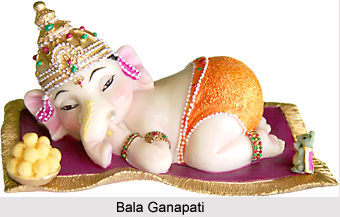 Bala Ganapati refers to the beloved noble child. It is one of the thirty-two forms of Lord Ganesha. He is the son of Lord Shiva and Goddess Uma (Parvati). The elephant god is portrayed with red complexion, which resembles the rising sun. In this form, Lord Ganesha has four arms and carries sugarcane, a mango, a jackfruit and a banana. Bala Ganapati also holds a modaka or sweet ball in trunk.
Bala Ganapati refers to the beloved noble child. It is one of the thirty-two forms of Lord Ganesha. He is the son of Lord Shiva and Goddess Uma (Parvati). The elephant god is portrayed with red complexion, which resembles the rising sun. In this form, Lord Ganesha has four arms and carries sugarcane, a mango, a jackfruit and a banana. Bala Ganapati also holds a modaka or sweet ball in trunk.
Bala Ganapati, the child form of Ganesha, is generally conceived in a seated posture. He is also depicted in sleeping and crawling posture as well. Bala Ganapati is representation of Prithvi (Earth), which indicates the affluence and fertility of land or earth. When a devotee worships the Bala Ganapati form, he is blessed success, good health. It is also believed that praying to the Lord also increases intelligence in children and removes their ill habits.
There are several temples of Bala Ganapati throughout India. The Thillai Ganapati in Sri Thillai Nataraja Temple, Chidambaram city in Tamil Nadu is the most popular Bala Ganapati Temple in the country. Chamarajanagar temple and Nanjangud temple, located in the district of Mysore, also worships this form of the Lord. Bala Ganapati is worshipped to remove tension and keep the mind calm. The noble child is adored with the Bala Ganapati Mantra, which can be chanted as "Karasthe Kadali Choothapana Sekshookmodakam Bala Suryamimam Vande Devam Balaganaadeepam".
This article is a stub. You may enrich it by adding more information to it. You can send your write-up at content@indianetzone.com




















